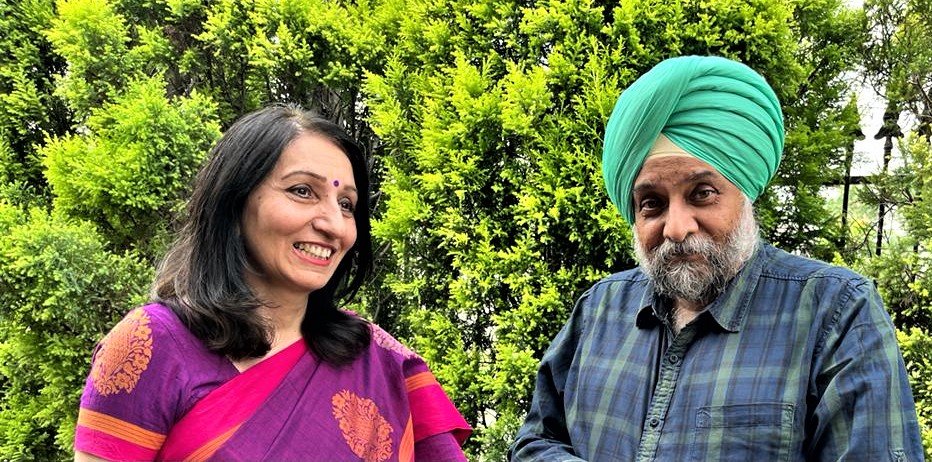The Tale of The Wise Owl
She was a bureaucrat who loved to write. He was a bureaucrat who loved to paint. So, this husband-wife duo, posted in Delhi and Jaipur as Principal Commissioners Income Tax, decided to put in their papers and pursue their muse. It was easier said than done. After settling down in home-town Chandigarh, Dr. Rachna Singh (IRS 1991) and Dr Harmeet Singh (IRS 1989) soon realised that the life of a poet, writer or artist was a continuous struggle. This set them thinking. The fields of literature and art were not new to them. Rachna Singh had a doctorate in English literature, wrote regularly for national dailies and had authored four books that were well received. Harmeet Singh had exhibited his watercolours in prestigious galleries pan-India and was adept at organizing art workshops and events. An idea took root that would satisfy their creative impulses and also help beleaguered writers and artists. So, The Wise Owl, an international literary and art e-magazine, was born in November 2021. Talking to The Sunday Guardian, Rachna Singh admitted that the first few months were a struggle but “soon poets, writers and artists from across the globe joined The Wise Owl community”. “My aim,” Rachna Singh said, “is to make our magazine one that every lover of literature and art across the globe is addicted to.”

When Ravan’s Effigy Was Burnt Lying Face Down
Lord Ram had killed Ravan by firing an arrow in the demon king’s ‘nabhi’ (navel)–commonly known as the belly button–to remove his secret self-defence amrit. But in Kaliyug, Ravan is dying in many other ways, or being worshipped, amusing everyone. In Bisrakh village in Greater Noida, Ravan is worshipped, Dussehra is not celebrated and no effigies are burnt as the people believe it to be his birthplace. Many residents of Sangola village in Akola district in Maharashtra perform the ‘aarti’ of Ravan on Dussehra as they believe they are employed and able to sustain their livelihood because of Ravan’s blessings. They believe in Lord Ram, but they also have faith in Ravan and do not burn his effigies. As a cub reporter with The Statesman, New Delhi, in 1972, I was given the assignment to cover the smallest Ram Leela on Dussehra in Chandni Chowk, near the Fountain. When I reached the Ground, it started raining lightly. Ram, Hanuman and Ravan–the main characters of the Ram Leela–ran for cover. The three effigies were getting drenched in Rain God’s showers. Suddenly, there was a big sound as Ravan’s effigy fell face down. For me, it was an unusual sight, and I sensed an opportunity for an exclusive picture as no other newspaper’s cameraman was there as they all concentrated in big Ram Leelas in Ram Lila Maidan and Red Fort Parade Ground where the President and the Prime Minister graced the occasion. Excited, I ran out to nearby Kotwali, adjacent to Gurdwara Sis Ganj, (Kotwali years later was given to the Sikh Gurdwara Prabandhak Committee), and made a telephone call to my office. Luckily, our legendary chief photographer Raghu Rai was still there; he was about to leave in five minutes for Ram Lila Maidan. I told him about Ravan effigy’s pity condition, lying face down in rain and muddy puddles. I requested him to come there instead of going anywhere else. He understood. After 20 minutes, Raghu Rai reached. Soon rain-soaked Ravan was burnt with some major efforts of using canisters of kerosene. The next day, The Statesman had a five column exclusive photo of Ravan’s effigy burning lying face down. It was not the era of social media. My stock went up in The Reporters’ Room as News Editor R.N. Sharma commented, “Tumne to paheli hi Ram Leela Mein Tir Mar Liya.” I remembered the 1972 incident when this year, in Kanpur, heavy rains and winds dampened the Dussehra spirits, wetting the three effigies of Ravan, Meghnad and Kumbhkaran. It posed a problem: how to burn the rain-soaked effigies. But at many places in Kanpur, Ravan’s effigy is not set on fire. Derapur Ram Leela in Kanpur has the tradition of throwing away the effigy from a mound. Daya Shankar Shukla, former chairman of the organising committee, told The Sunday Guardian that the tradition had continued since inception but of late, it had been tweaked. Earlier, after Lord Rama killed Ravan, his effigy was taken on a bullock cart to Lanka Teela from where it was thrown.
‘Character Certificate’ needed To Cover Events
It was a big embarrassment for the BJP-ruled

